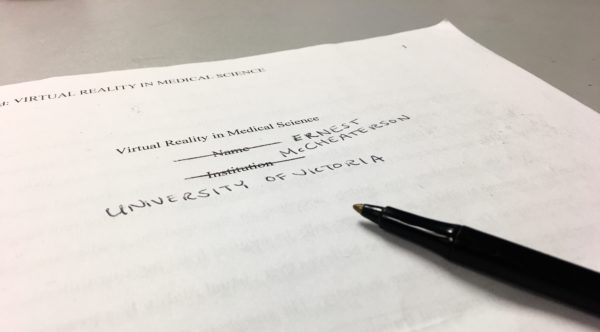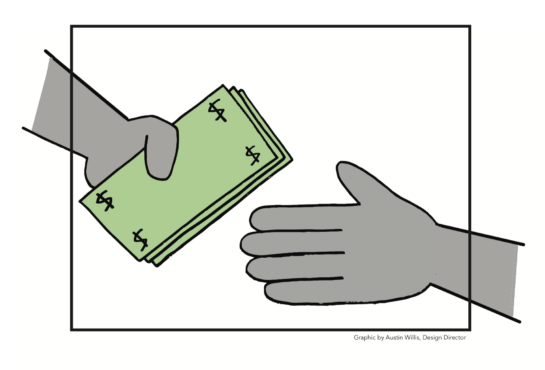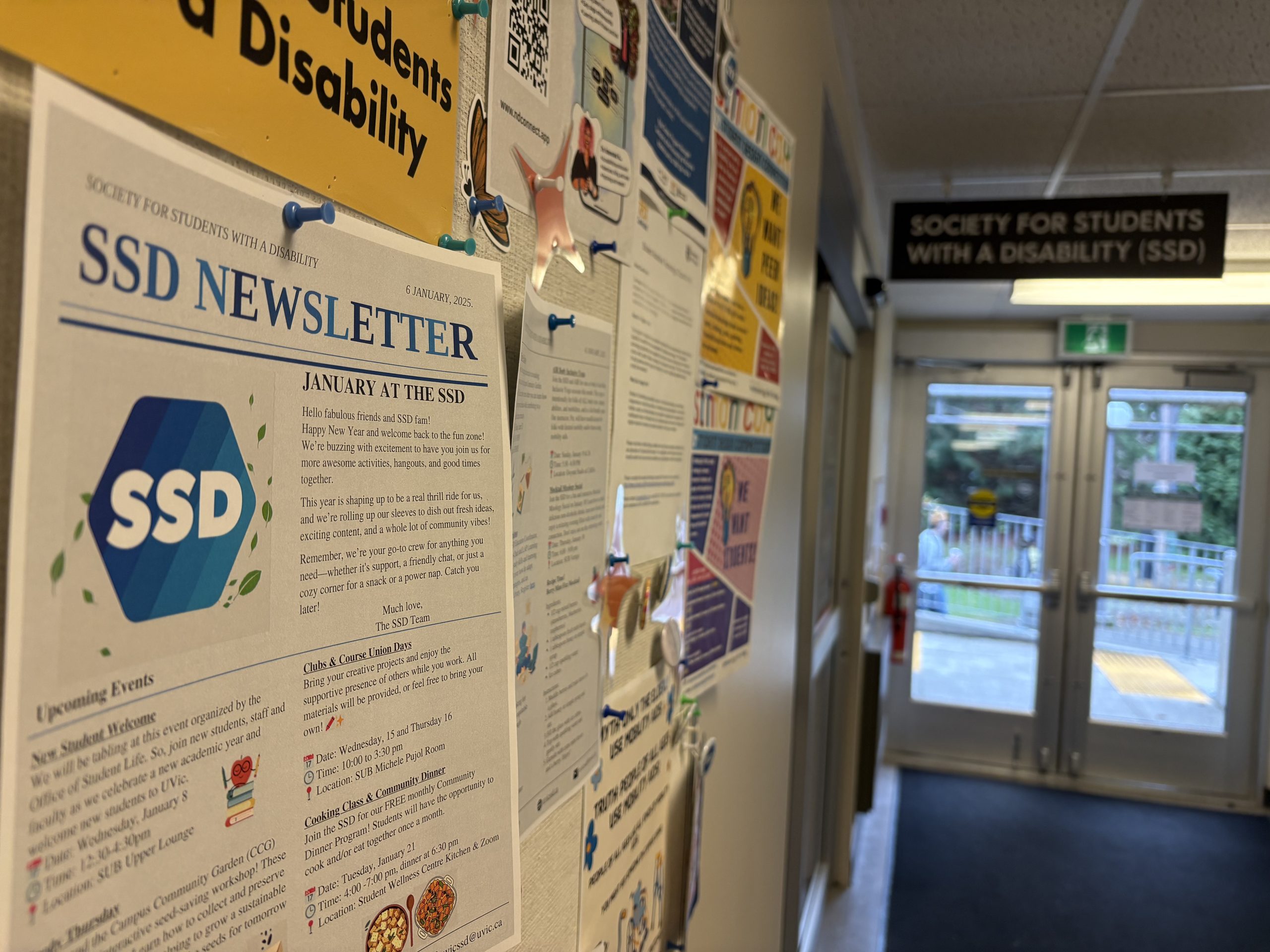
We’ve all been there. You looked at the assignment months ago and you thought about your topic, but somehow it’s the night before it’s due and you’re in a total panic because you let it slip.
You have several choices at this point. You can pull an all-nighter and churn out a rushed, generic, not-great essay that will hopefully get you a passing grade. You can email your professor and ask for an extension. You can also not email your professor and accept that you’re going to get a chunk taken off your grade because it will inevitably be handed in late. Or, you can frantically look online and find a host of easy-to-use websites — writemypaper4me.org, papercoach.net, buyessayfriend.com, essayshark.com — and rush-order a custom paper written just for you.
As an Associate Professor in the English Department and an advisor for the Academic Writing Requirement Program at UVic, Erin Kelly has seen her fair share of suspicious essays. Her advisory role means she is charged with handling cases of academic integrity.
Often, Kelly says that these essays have violated academic integrity rules unintentionally, such as a student who forgets to cite a source or misunderstands how to properly paraphrase. Other times students will admit that they went online the night before and cut and pasted several paragraphs and were simply too rushed to substantially change the content.
But every now and then, Kelly will run across a paper that has a strange ring to it. She can’t quite put her finger on what it is, but there’s something that’s not quite right.
It is these sorts of papers that eventually inspired Kelly’s own research into the many essay-writing services that exist online.
“So I decided to order a paper,” says Kelly. “And I have to say I’m not entirely surprised by what I got.”
♦
“I would say that what I received for my money just in terms of the quality of the work — it’s a simulacrum of a research paper… If you don’t squint too hard it sure looks like one. As soon as you squint, everything about it is strange.”
♦
Kelly used the website writersperhour.com to generate her paper. She requested a paper based on an assignment for a basic English 101 class, equivalent to an English 135 class at UVic. In the submission form, she claimed she was an undergraduate student, that she needed a research paper, and that it needed to be in APA style with 10 sources. She included the assignment sheet and requested that it be completed in five days. For an extra fee you can get the paper rush-ordered, and it costs less if you give the company more time. All of these specifications are options available in the request form.
Five days and $125.94 later (with a Black Friday discount), the paper — six-pages double-spaced — was ready.
If you go to the company’s frequently asked questions on their website, beneath the question “Is it cheating?” they respond: “Simply put, NO.”
How can they possibly defend this? It’s simple, really: by ensuring all users of the site agree to the mandatory terms and conditions. Beneath the heading titled “No Plagiarism” in the T&Cs reads: “You may not put your name on the delivered product. All products and/or other written materials are for research and/or reference only. We do not condone, encourage, or knowingly take part in plagiarism or any other acts of academic fraud or dishonesty.”
An interesting caveat, considering the cover page of the word document that Kelly received contains the words ‘Name’ and ‘Institution’ — a clear invite, you’d think, to replace those words with your own name and institution.
The risk of these papers infiltrating university classrooms could be very real — if it weren’t for the fact, Kelly argues, that the paper she received was so bad.
“I just know that based on how much time it would take me, a PhD in English who has published things, that if somebody said to me, I need a five to seven page essay that has a minimum of 10 sources — and I need it a week from now — in order to really do a good job, what they’re charging is not enough per hour to make it worth my while,” she says.
Indeed, upon looking over the paper’s introductory paragraph, it becomes immediately apparent that the essay lacks a clear argument, instead stating that it will argue “how virtual reality is impacting medicine today especially in surgical fields and also discuss the future promises of the application.”

Is the paper weak enough to get a failing grade, though?
“Maybe,” according to Kelly. “And I think some of the maybe there is assuming an unfortunate reality, which is you have instructors who have large classes, they have a ton of marking to get through, [and] they’re expected to get through it very, very quickly.”
“I would say that what I received for my money just in terms of the quality of the work — it’s a simulacrum of a research paper,” Kelly says. “If you don’t squint too hard it sure looks like one. As soon as you squint, everything about it is strange.”
For educators, what’s the solution to this seemingly impossible dilemma? As Kelly points out herself, if you’re teaching a first-year class with hundreds of students, it can be hard to pick out the website-generated essays from the legitimate ones.
There are online resources that scan the internet, even library databases, for strings of words that will catch plagiarism. The best known program, says Kelly, is turnitin.com. UVic used to subscribe to this program, however due to the cost (upwards of $60 000 per year), they are no longer users.
♦
“I just reject the entire assumption that this is some sort of adversarial relationship where students are trying to get away with something and we have to constantly thwart them.”
♦
Kelly does not disagree with the university’s choice, as she sees the program as ineffective. Many times, students told her that they ran their paper through Turnitin because they still had access to the program through their high school, and that their paper came out clean. But, says Kelly, just because you changed a few words in your paper to ensure that Turnitin can’t read a certain string of words does not make it plagiarism-free.
“I just think that Turnitin teaches people bad habits,” says Kelly. “Turnitin is not pedagogical. Turnitin is policing. I’m not interested in policing, I’m interested in teaching.”
Janni Aragon, adjunct assistant professor of Political Science at UVic and the Director (currently on leave) of UVic’s department of Technology Integrated Learning, agrees with Kelly.
“I was a mid-level user of Turnitin,” she says. “At the time, I was teaching a large first-year course and would use it when I suspected that a student was not citing the original source material or when a TA approached me with an assignment.”
According to Aragon, only about five per cent of her students would be found to be plagiarizing, and of that number, very few had done so intentionally.

“I’m not a fan of Turnitin,” she says. “U.S. cloud, students’ intellectual property, and the whole ‘gotcha’ for students. I think we need to teach students how to cite and integrate sources better in all our classes.”
So is there any solution to the problem of cheating, especially when the internet provides students with a wide array of easy-to-access resources?
“First of all I just reject the entire assumption that this is some sort of adversarial relationship where students are trying to get away with something and we have to constantly thwart them,” says Kelly.
Yet according to James Lang, author of Cheating Lessons: Learning from Academic Dishonesty, approximately three-quarters of university students in the United States cheat at some point during their undergraduate degree.
Clearly the ‘gotcha’ method, as Aragon says, does not work. Kelly points to this as well.
♦
The strategies used to prevent cheating are the same strategies that will improve students’ educational experience, too, which can make the extra time and effort worthwhile.
♦
“The problem with a lot of discussions about academic integrity is that it’s almost assuming this relationship of cops and robbers,” she says. “The students are the robbers, the students want to cheat, the students want to get away with as much as they can. And then our job as instructors is to stop them, and if only we can figure out the right exam conditions and the right kind of assignment and the right this and the right that, well then, no one can ever cheat.”
Lang, meanwhile, says that technology is not really the problem.
“The current research on this subject suggests that neither the rates of cheating nor the principles for addressing it are much different in virtual environments than they are in real ones,” he writes in his book.
“While online courses provide students with more opportunities to cheat, those students don’t seem to be doing so any more than their traditional classroom counterparts.”
According to Lang, the strategies used to prevent cheating are the same strategies that will improve students’ educational experience, too, which can make the extra time and effort worthwhile.
These strategies can be as simple as explaining to students the purpose of an assignment and why it is worthwhile for their overall education.
“Students, like all of us, want the answers to questions, both big and small, about their lives and their futures and their world,” writes Lang. “They are anxious to know what awaits them in the world beyond college … They have questions, and thinking about how our courses tie into these big questions can help create connections between their concerns and ours.”
Another solution, which Kelly points to as a successful strategy, is to scaffold, which means splitting up an assignment into more manageable chunks. The downside to this strategy is that it involves more grading for the instructor, which can be overwhelming if it’s a first-year class of over 100 students. Lang calls this “lowering stakes.”
Providing students with creative freedom is also a way to reduce the likelihood of cheating.
“We have to give the students opportunities to respond in authentic ways over which they have some control,” writes Lang.
There is no easy fix to cheating. Just like writing an essay, there is a lot of work involved with creating an environment that discourages cheating over the long-term.
But there’s also a lot of work that comes with cheating, as Kelly demonstrated with the essay that she purchased.
First, you have to spend the money. But you’ll also likely have to edit the essay that you receive to make it readable. And, if you get caught, it’s not worth it at all.
Clearly these essay-writing services are being used, as demonstrated by the ample selection a student can choose from. And Kelly sees it as a consumer fraud issue because of the discrepancy between what it says in the terms and conditions and the prompts on the essay’s cover page.
“Students are apprentices,” she says. “That doesn’t make cheating okay, that doesn’t make academic integrity violations okay, but it can be a learning experience. For these companies this is not a learning experience. This is just wrong and evil and bad.”
Ultimately, there will always be cheaters. But if you’re here to learn and your assignments make sense, cheating doesn’t really make sense, argues Lang.
“Students who want to learn, and who have been given all of the tools they need to learn, have no need to cheat.”









